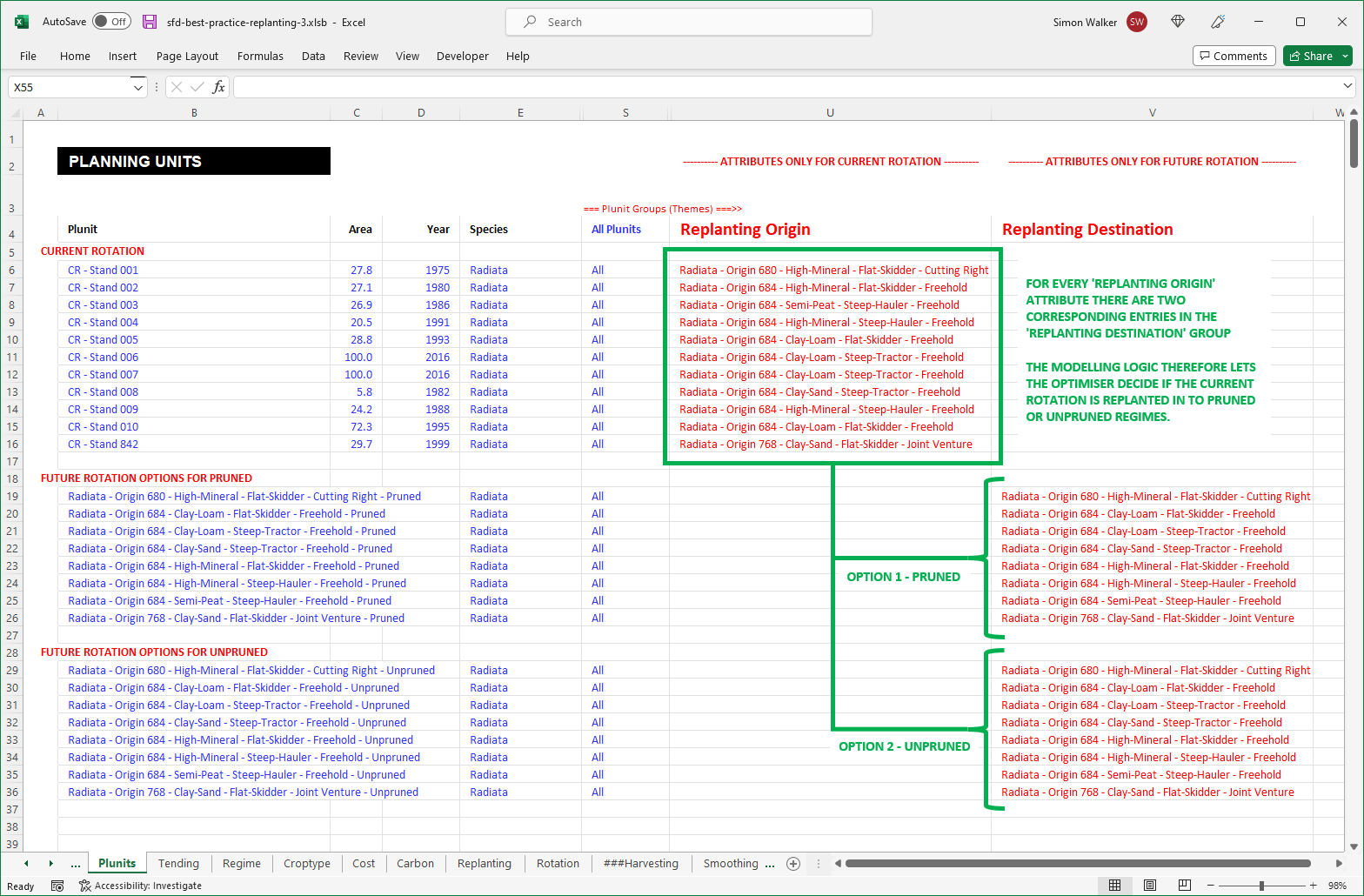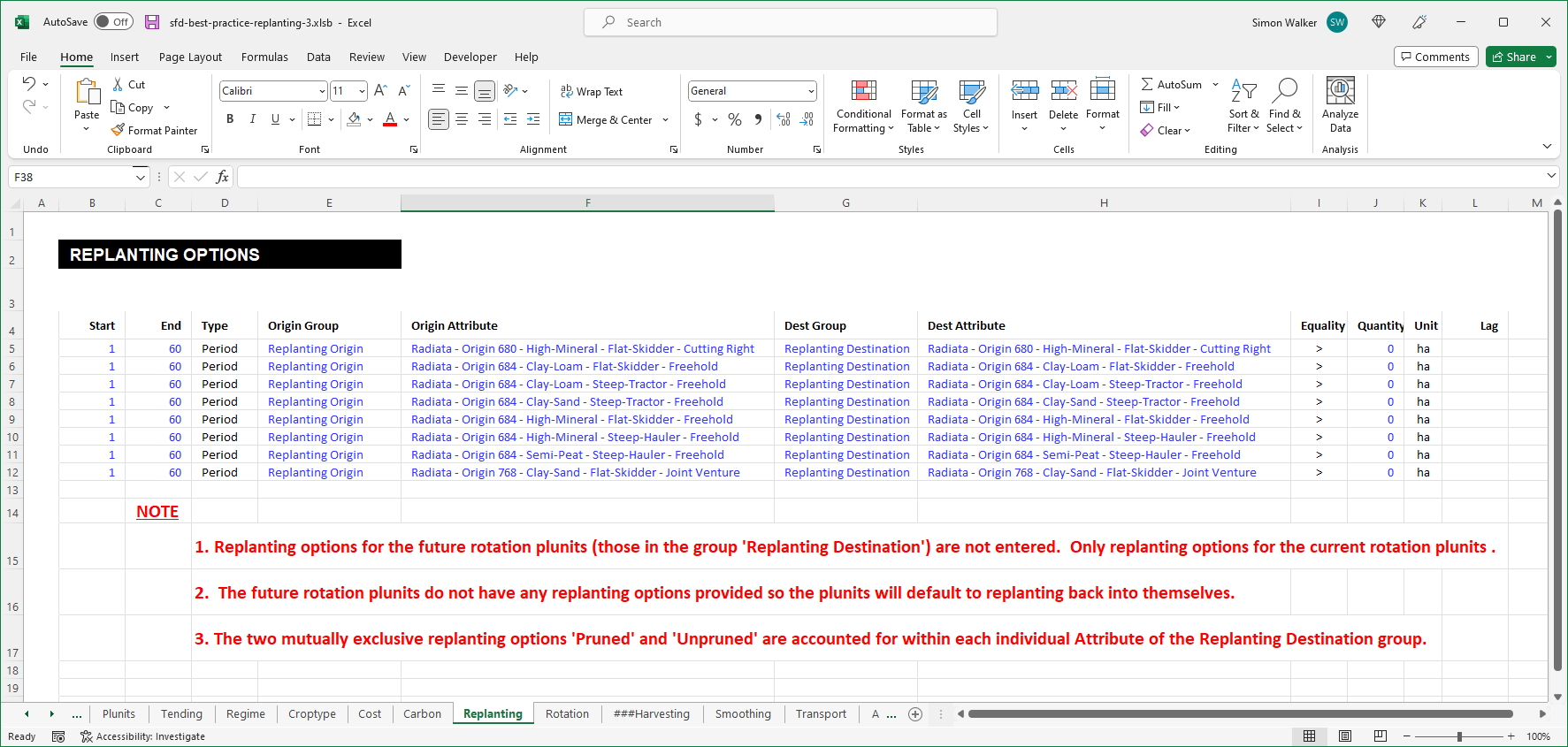Best Practice for Modelling Replanting Options¶
The Replanting worksheet is the transition between the current rotation, i.e. stands that have planted area at some point in the first period of the model, and the future rotation, i.e. stands that have an age less than the modelling period. In a forest estate model that spans 3 or 4 rotations the decision tree of potential replanting options can grow very large, very fast. Forest estate models that take a long time to build and solve are often suffering from an inordinate amount of redundant replanting options that will never eventuate in practice, but for which the linear programming optimiser has to construct and consider equally.
Recommended Best Practice for the Replanting worksheet is a compromise between giving the transition from the current rotation to the future rotation enough resolution that a well constructed estate model will find a robust and logical outcome, while preventing the future rotations having an exponential growth in regeneration options as they transition from 2R to 3R to 4R.
Ultimately the number of non-zero values in a sparse matrix is what defines optimisation solve times. Focusing on finding ways to keep the non-zero count as low as possible while not sacrificing model utility or accuracy is best practice.
A well structured model with a lot of resolution i.e. a stand level model of the current rotation coupled with adequate operational resolution for the future rotation will capture all the important attributes so that as the current rotation transitions to the future rotation the plunits will end up in their most appropriate regimes. Once decided, there is not much point recreating every conceivable option again for the future rotation as it transitions through successive replanting processes.
What this means for the model is that the current rotation gets a wide range of choice in considering potential future rotation options, but the future rotation stays in the same regime for its subsequent rotations.
Plunits Worksheet¶
The Plunits worksheet below shows how to configure two user-defined groups, Replanting Origin and Replanting Destination, so that the current rotation plunits are only assigned attributes in the Replanting Origin group and the future rotation plunits are only assigned attributes in the Replanting Destination group. Each group is exclusive to either the current or the future rotation. The worksheet also shows two sets of future rotation plunits, one set for a Pruned regime with a pruned yield table, and a second set for an Unpruned regime with an unpruned yield table.
The modelling logic shows two core concepts of forest estate modelling. Firstly, how to set up best practice replanting options so that the current rotation gets a lot of choice while the future rotation is assumed to replant back into itself; and secondly how to give replanting optionality to the current rotation so that the optimiser can choose the best replanting option for each current rotation plunit as they are harvested, i.e. the optimiser will choose either a pruned or an unpruned regime based on their value contribution.
Replanting Worksheet¶
The Replanting worksheet uses the Replanting Origin and Replanting Destination groups to define the options for regenerating the current rotation. Importantly, there are no options given on the Replanting worksheet to regenerate the future rotation plunits. The future rotation plunits will therefore replant back into themselves. This is the default behaviour when a plunit has no replanting option explicitly allocated on the Replanting worksheet.
The two alternative regimes choices, Prune or Unpruned do not have to be individually entered on the Replanting worksheet. As is shown above in on the Plunits worksheet each individual attribute in the Replanting Destination group can contain the two regime choices. Therefore each row on the Replanting worksheet is essentially giving the current rotation two choices for replanting, Pruned or Unpruned.
Summary¶
The modelling logic to implement this best practice example for replanting is:
- Always have a ‘Replanting Origin’ group and a ‘Replanting Destination’ group on the Plunit worksheet.
- The Replanting Origin group should only have attribute entries for the current rotation plunits.
- The Replanting Destination group should only have attribute entries for the future rotation plunits.
- The Replanting worksheet should only define options for the group Replanting Origin to go to the group Replanting Destination.
- Do not define any replanting options at all for the group Replanting Destination on the Replanting worksheet.
- All the future rotation plunits will default to replanting into themselves because a valid replanting option has not been defined.
The naming of the attributes in the Regeneration Origin group is important. The naming convention should capture all the fundamental forest aspects that you need to keep consistent between the current and future rotations, i.e. slope class, site index, soil type, origin, tenure etc. you can then use the same naming convention for the Replanting Destination group. This is how the example download below has been configured.
Alternatively, this best practice recommendation does not prevent having a stand level forest description for both the current and future rotations. The same logic applies; simply exclude the future rotation plunits from being explicitly accounted for on the Replanting worksheet and the area will stay in the plunit that it replants into from the current rotation.

